Moody’s downgrades Senegal to Caa1 amid rising debt concerns
Electric vehicles were surging, until Washington abruptly hit the brakes. Now the US faces a precipice in its adoption curve. Will it recover or fall behind?
1. A Turning Point in US EV Policy
On 4 July 2025, the US crossed a policy Rubicon. Congress passed the One Big Beautiful Bill and President Trump signed it the same day, officially terminating the federal EV tax credits by 30 September 2025—a full seven years ahead of schedule.
Initiated under the Inflation Reduction Act (IRA) in 2022, these credits, up to $7,500 for new EVs, $4,000 for used, and as much as $40,000 for commercial vehicles, were once hailed as a cornerstone of the clean transportation transition. Their removal marks a radical shift at a moment when electric mobility was just beginning to gain mass-market traction.
The administration claims the move will save the federal government $170 billion over the next decade. While fiscal prudence is understandable, the timing raises urgent questions about the future of emissions reductions, domestic EV manufacturing, and America’s competitive stance in the global clean technology race. These incentives were designed not only to lower upfront vehicle costs but also to catalyze industry investment, consumer adoption, and supply chain growth.
By pulling the plug so abruptly, the government risks destabilizing an industry still dependent on consistent policy signals to plan production and investments. This sudden withdrawal could discourage automakers and suppliers from expanding EV production capacity, potentially ceding technological leadership to international competitors.
As the nation halts its electric vehicle strategy, the broader implications remain as uncertain as they are consequential, creating a policy vacuum at a critical juncture for climate and industrial policy.
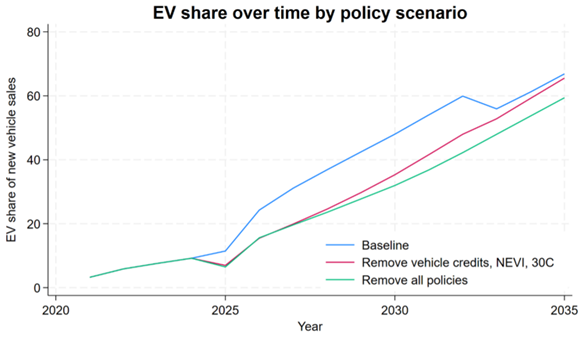
Source: The Salata Institute, Harvard University
The rollback of the EV tax credits goes far beyond merely ending rebate checks, it represents a sweeping and systematic reversal of the federal strategy carefully constructed since 2022 to accelerate electric vehicle adoption. By 30 September, support for EV buyers will vanish entirely, cutting off incentives for both new and used electric vehicles that had previously qualified for credits up to $7,500 and $4,000, respectively.
Equally significant, commercial and leasing subsidies, some worth tens of thousands of dollars, have also been eliminated, sharply reducing the economic motivation for fleet electrification, a critical segment for scaling clean transport.
Infrastructure investment—a key pillar of the transition—is next to fall victim. The National Electric Vehicle Infrastructure (NEVI) program, originally funded with $5 billion under the 2021 Bipartisan Infrastructure Law to build fast-charging stations along highways at fifty-mile intervals, was abruptly halted by the administration in February.
This suspension, despite ongoing legal challenges from several states and a partial injunction restoring some funding, has created substantial uncertainty within the EV charging sector, delaying planned deployments and shaking the confidence of private investors and utility partners vital to expanding the national charging network.
Regulatory protections that underpin long-term emission reductions are also unravelling. Shortly after reinstating federal oversight, President Trump revoked California’s Clean Air Act waivers, using the Congressional Review Act to strip the state and its partners of the authority to enforce stricter emissions limits and zero-emission vehicle mandates.
Meanwhile, the administration has signaled intentions to revisit and potentially weaken national greenhouse gas and fuel economy standards for vehicles manufactured after 2027, though formal rulemaking has yet to be finalized.
Furthermore, the Inflation Reduction Act’s production tax credits for domestic battery and critical materials manufacturing are now under threat. These incentives had fueled new giga-factory construction and supply chain investments critical for scaling US-based EV production. Their rollback jeopardizes these investments and risks stalling the growth of a domestic manufacturing base essential for long-term competitiveness.
Taken together, these changes represent the most drastic reversal of US EV policy in over a decade, systematically dismantling what was once a multifaceted system of incentives, infrastructure investment, and regulatory guardrails designed to accelerate electrification, raising profound questions about the future trajectory of American clean transportation.
2. Short-Term Surge and Market Reactions
As federal EV subsidies near expiration on 30 September, dealers report large inventories and are aggressively cutting prices to spur last-minute sales. {{13994|Tesla (NASDAQ:TSLA)}} maintained strong Q2 volumes despite a 9% drop year-over-year, and GM hit a record 46,000 EV sales in the quarter. This short-term surge, driven by consumers rushing to claim rebates, masks a looming risk: without subsidies, price-sensitive buyers may hold back, causing a potential slump in mainstream EV adoption.
Investor reactions have been mixed. Pure-play EV companies like {{1179312|Rivian (NASDAQ:RIVN)}} and {{1166456|Lucid (NASDAQ:LCID)}} saw stock gains: 4.6% and 8.8% respectively, thanks to continued eligibility for credits through leasing or battery sourcing rules. Tesla’s shares lagged, as its earnings rely heavily on emissions-credit revenue and consumer incentives now in jeopardy. Overall, while smaller EV makers may benefit initially, mass-market demand faces uncertainty as price premiums rise and promotional pushes fade.
Harvard’s Salata Institute modelled the impact of rolling back EV policies. Under the Inflation Reduction Act (IRA), EVs were expected to capture 48% of new vehicle sales by 2030. Removing just the consumer tax credits cuts this to 42%. When combined with halted infrastructure funding, weakened state mandates, and revoked emissions rules, adoption could drop further to roughly one-third of new sales.
This decline has direct environmental consequences. The rollback may add 20 to 44 million metric tons of CO₂ emissions in 2030, roughly equal to putting nearly ten million gasoline cars back on the road. The US Energy Department similarly forecasts a 2–3-year delay in reaching EV adoption milestones. These setbacks threaten domestic factory ramp-ups and broader industry momentum just as EVs approach mass-market viability.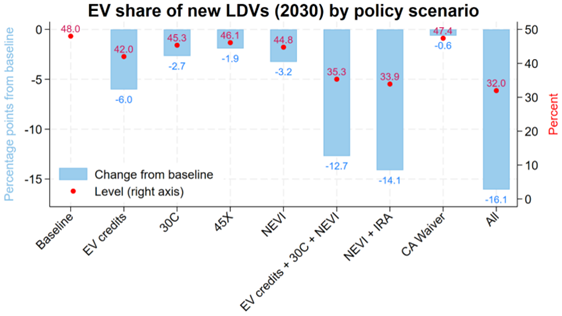
Source: The Salata Institute, Harvard University
Yes, removing credits yields hard federal savings: around $168.5 billion over a decade. But that gain comes at a steep price: lost climate benefits, weakened supply chains, a painful geopolitical retreat, and crucially, significant equity concerns, as the most vulnerable consumers lose access to essential financial support.
The rollback also freezes $12 billion in NEVI spending, while shelving IRA battery production credits (45X) saves another $7 billion. Ironically, the California emissions waiver scrapping adds almost nothing to savings, but hurts EV targets. In sum, most financial savings come from a single move, the credit removal, but nearly every other aspect contributes heavily to climate and industrial fallout, raising the question: which consumers will slip through the cracks?
Not all buyers will be affected equally by the end of federal EV incentives. Lower‑ and middle‑income purchasers, key to achieving mass-market adoption, stand to lose the most, as they often relied on credits to bridge the price gap between electric and conventional vehicles. With average EV transaction prices still significantly above those of comparable gas-powered cars, subsidies were frequently the deciding factor in affordability.
At the other end of the spectrum, luxury EV buyers, such as those purchasing from brands like Rivian and Lucid, have more financial flexibility and continue to benefit from leasing structures and private discounts that can soften the impact of subsidy removal.
Automakers are responding with targeted dealer incentives, manufacturer rebates, and more aggressive lease programs. While these measures may help cushion the transition, they lack the scale and consistency of federal policy and are unlikely to fully offset the loss of broad-based subsidies.
State governments may attempt to fill the void, such as California and Massachusetts, whose strong political and fiscal support could maintain some EV incentives. Still, without a coordinated federal effort, the effectiveness of such measures will vary widely and likely leave lower-income communities at a disadvantage in many parts of the country.
At the same time, the IRA’s EV push had driven substantial factory investment including giga-factories, battery plants, and supply chain hubs in Republican districts. Now many stand on unstable footing.
Transport analyst forecasts suggest 40 to 60% of planned EV factories will be at risk if policy support evaporates. {{239|General Motors (NYSE:GM)}} and Ford have already delayed or cancelled giga-factory plans, Tesla postponed its budget model plans, and even European and Asian competitors are recalibrating their US strategies amidst increased uncertainty. In effect, the US risks shrinking its EV manufacturing base just as global competitors accelerate.
Globally, EV adoption has soared: approaching 25% of new car sales in 2025. With China leading the charge, Europe aggressively enforcing quotas and subsidies, the US is veering off the main track.
China’s EV-led economic strategy, which includes concentrated supply chains, export ambitions, battery dominance, will benefit from weakened US competition. This could undo years of investment and mission-driven innovation across multiple sectors. If domestic policy bakes in subpar uptake, the US forfeits leadership, and all the jobs, IP, and influence that come with it.
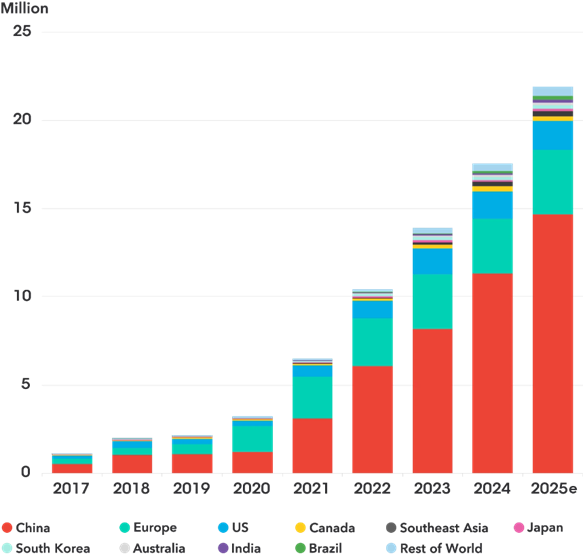
Source: Bloomberg NEF, Eco-Movement, China Electric Vehicle Infrastructure Promotion Alliance, various public and private sources
The rollback hits infrastructure hard. NEVI, which aimed to deliver fast chargers every 50 miles along interstates, is now paused. The result: rural America and renters in urban corridors remain without charging access. With range anxiety still a barrier, the lack of national charging infrastructure will reinforce urban-rural divides and limit where EVs can actually be used. This also threatens networks like Electrify America, which rely on policy support and usage scale.
The climate impact is equally stark. This move adds millions more tones of CO₂ to America’s 2030 emissions than projected. Electric vehicles, key to decarbonizing transport—currently the nation’s single largest source of emissions—will backslide. Climate goals become less attainable, climate adaptation more difficult, and emergency scenarios more likely.
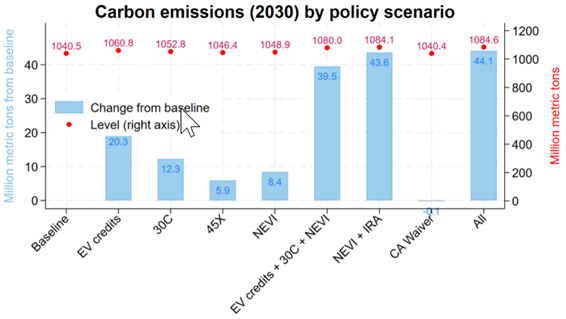
Source: The Salata Institute, Harvard University
What Happens Next (LON:NXT): Looking Ahead
In the short term, a wave of EV purchases is expected as consumers rush to secure rebates before the deadline, supported by dealer discounts and promotions. However, once federal credits expire, demand are likely to fall sharply, settling at a lower baseline.
Automakers and dealerships plan to counter this gap with increased incentives and leasing deals, while some states may continue offering limited subsidies. Yet, these fragmented efforts cannot replace the nationwide reach or consistency of federal support, especially for price-sensitive buyers.
Globally, the US risks losing ground. China’s EV market continues to surge with strong government backing, while Europe tightens emissions standards and accelerates zero-emission vehicle mandates. Unless policies adjust, US may fall behind key competitors in EV adoption, manufacturing, and innovation.
Longer term, improvements in battery technology and more model availability could reignite growth by the mid-2030s. Still, the five-year gap created by this policy reversal represents not just a delay but lost opportunities in emissions reductions, supply chain development, and industrial leadership.
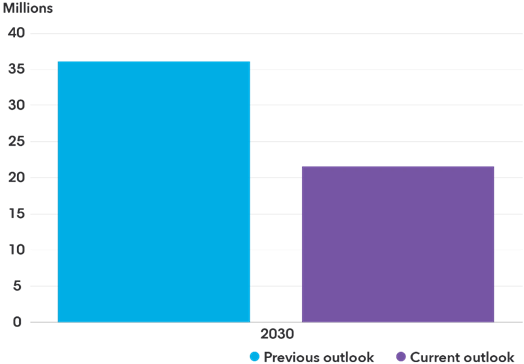
Source: Bloomberg NEF
Conclusion: A True Fork in the Road
The “EV cliff” is now law. On 4 July 2025, President Trump signed the “One Big Beautiful Bill,” officially ending federal EV tax credits and gutting the backbone of US electric mobility policy. This isn’t just a rollback: it’s a rupture. Growth forecasts are being cut, emissions targets thrown off course, and factories now face dwindling demand.
The US will remain in the EV race, but no longer as a frontrunner. Global competitors will shape the next era of transport innovation while America risks falling behind. Some policy rebound may come, but not without cost. 4 July may still mark independence, but in 2025, it also marked the day America chose to stall its electric future. Whether it regains momentum depends on what happens next.
